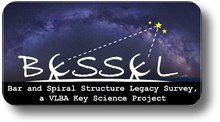Micro-arcsecond VLBI Astrometry
Over the past decade, we have developed and tested the techniques that have enabled parallax measurements with accuracies of better than 10 micro-arcseconds. This meets or exceeds Gaia's parallax accuracy. While VLBI astrometry will not approach the number of parallaxes that Gaia will do, we can freely probe the entire Galactic plane, whereas Gaia will be severely limited there by extinction (e.g, Av=30 mag toward the Galactic center). Before beginning this project, we determined trigonometric parallaxes to 11 star forming regions with accuracies of order 10 micro-arcseconds. We also measured absolute proper motions with accuracies of order 1 km/s. These results have been published in a series of papers in the Astrophyscial Journal and Astronomy & Astrophysics since 2009.
Galactic Structure, Fundamental Parameters, and Noncircular Motions
With the current data, we already locate several spiral arms. Combining positions, distances, proper motions, and radial velocities yields complete three-dimensional kinematic information. By fitting the measurements to a model of the Galaxy, we estimate the distance to the Galactic center and a circular rotation speed:
Θo = 236 ± 7 km/s.
The ratio Θo/Ro can be determined to higher accuracy than either parameter individually, and we find it to be 30.32 ± 0.27 km/s/kpc, in good agreement with the angular rotation rate determined from the proper motion of Sgr A*. The data favor a rotation curve for the Galaxy that is nearly flat between Galactocentric radii of 5 and 16 kpc. Kinematic distances are generally too large, sometimes by factors greater than 2; they can be brought into better agreement with the trigonometric parallaxes by increasing Ro from the IAU recommended value of 25.9 km/s/kpc to a value near 30 km/s/kpc. Finally, our estimates of Θo and Ro, when coupled with direct estimates of Ro, provide evidence that the rotation curve of the Milky Way is similar to that of the Andromeda galaxy, suggesting that the dark matter halos of these two dominant Local Group galaxy are comparably massive.
Published in Reid et al. 2009 ApJ 700, 137, Reid et al. 2014 ApJ 783, 130, and Reid et al. 2019 arXiv:1910.03357.
see also NRAO or CfA press releases
![[photo will come]](images/Reid_fig1.png)
Milky Way with measured parallaxes (from Reid et al. 2019)
|
This image of the Milky Way is based on 200 trigonometric parallaxes for masers in massive star forming regions from two large radio astronomy projects, the Bar and Spiral Structure Legacy (BeSSeL) Survey and the Japanese VLBI Exploration of Radio Astrometry (VERA) to survey the Milky Way from the inside out. These parallaxes allow us to directly measure the forms of spiral arms across roughly one-third of the Milky Way, and we have extended the spiral arm traces into the portion of the Milky Way seen from the Southern Hemisphere using tangencies along some arms based on carbon monoxide emission (Reid et al. 2019). The locations of a large numbers of star forming regions found in various catalogs were obtained by using our Bayesian distance estimator (Reid et al. 2016) in order to fill out the spiral arm model. According to these new results, the image above has been created by a combination of computer and handwork. In order to paint a realistic image, we have considered the likely appearance of the component elements of the spiral arms, such as young OB stars, giant HII regions, young star clusters, nebulas and filaments based on the images of a variety of spiral galaxies. The image clearly presents the Milky Way as a barred spiral galaxy with four major arms and some extra arm segments and spurs. It is currently the most scientifically accurate visualization of what the Milky Way looks like. |
![[photo will come]](https://www3.mpifr-bonn.mpg.de/staff/abrunthaler/BeSSeL/images/new_view/202002031523403515n3wz2.png?iid=9470)
Reid & Zheng 2020, SciAme, Vol. 322, No. 4, P31. Click here for additional version.
|
